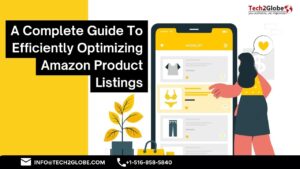Summary: Wondering why your product isn’t ranking or unsure which strategy to implement for better results? No worries! In this blog, you’ll find the top 5 strategies to improve your Amazon SEO ranking. Plus, learn how to boost your listings and increase sales.
Key Takeaways
- Research keywords carefully to identify pertinent terms for your Amazon listings, so enhancing search engine results and sales.
- Clear keyword-rich product titles and description details will help improve Amazon’s SEO and draw consumers in.
- High-quality images will help products stand out since their visual appeal greatly influences customer purchase decisions.
As of 2024, there are 9.7 million ( approximately) sellers on Amazon. With Amazon stores looking to grab opportunities to rank higher in consumer searches, they are constantly seeking solutions on how to optimize Amazon listings. Undoubtedly, with so many sellers to compete with, it is not easy to stand out and capture attention.
However, with the right implementation of each Amazon SEO strategy, success will become more attainable. Whether it’s the product title, images, description, reviews, branding, or pricing, everything matters in making your product stand out to buyers and encouraging them to make a purchase.
Working of Amazon SEO
Most shoppers start their Amazon journey by typing specific items or phrases into the search bar. This simple action opens a world of possibilities, allowing them to explore a vast range of products. For a different approach, Amazon’s organized departments, like Pet Supplies, Sports Items, or Home Decor, offer a structured way to browse.
What Amazon SEO can do: Interestingly, anyone selling on Amazon can benefit from search engine optimization (SEO). From small resellers to established brands, Amazon product listing optimization with relevant keywords can increase visibility and sales. Additionally, sellers enrolled in the Amazon Brand Registry have an extra advantage with tools like Search Query Performance and Top Search Terms that provide in-depth insights.
Refining the Search and Discovering Products: To narrow down results, shoppers can use filters based on factors like shipping speed, customer reviews, and price. Amazon also helps customers discover new items through curated collections featuring bestsellers, recent releases, and trending products.
Comparing and Buying: Once the search yields results, customers can compare prices, shipping options, and product details side-by-side. Moreover, a product’s popularity within its category is indicated by the Amazon Best Sellers Rank (BSR).
Paid Advertising: To gain an edge over competitors, many sellers use Amazon’s Sponsored Products ads. These paid advertisements highlight products, capturing shoppers’ attention and driving traffic to product listings.
SEO Optimization Tips to Rank on Amazon
Relying on just one Amazon SEO strategy isn’t effective and won’t lead to success. To truly excel, you need to follow comprehensive approaches. Your audience won’t be able to discover your products unless you raise your Amazon rankings. Here are some ways to enhance your Amazon SEO ranking:
- Conduct Thorough Keyword Research
- Optimize Product Title and Description
- Use High-Quality Images
- Focus on Pricing
- Build a Strong Brand Presence
1. Conduct Thorough Keyword Research
Keywords are like the backbone of SEO. Yes, you read that right because keywords form the foundation for all SEO strategies.
So, how do you start keyword research? Firstly, you should target keywords for product titles, descriptions, ads, etc. Here’s how you can do it:
- Enter multiple keywords in the “Amazon search box.” You may take ideas from the drop-down menu and create a comprehensive list of keywords for your offers.
- Check competitor offers for words and phrases that could improve your content.
- SEO tools and Amazon PPC service can help you find keywords, related phrases, demand, and strategy data.
Secondly, remember to use short-term and long-term keywords. Short-tail keywords are broad, general search terms like “dresses” or “shoes” with high search volume but intense competition, making it challenging for smaller sellers to rank high. Whereas long-tail keywords are more specific, for example, “men’s waterproof running shoes with good arch support,” with lower search volume but less intense competition.
2. Optimize Product Title and Description
The title of your product is like a digital shopfront sign. You have one chance to get a customer’s attention and get them to click. When writing titles, you should consider what the buyer cares about the most. Thus, you must include essential details:
- Product type: Clearly state what the product is.
- Brand name: If you have a strong brand, include it.
- Key features: Highlight unique selling points like color, size, material, or function.
For example, instead of a generic “Blue T-Shirt,” try “Soft Cotton Men’s T-Shirt – Navy Blue, Regular Fit.”
Also, consider what details you want to see before buying. Ensure you use the keywords best for your product and audience. Remember that Amazon lets you use up to 200 characters, but try to stick to around 60 for the best visibility. With Amazon product SEO in mind, put the most important keywords at the top.
Moreover, when it comes to “Product descriptions,” avoid keyword stuffing and focus on highlighting the product’s USPs, benefits, and features. Here’s what your product description must include:
- Core features: Make what your product does clear.
- Benefits: Describe how these features make life better for the customer.
- Details about the materials and specs: Give detailed information about what’s in the product.
- How to take care of it: Help people care for the product.
- With or without a warranty: Trust and believe in yourself.
3. Use High-Quality Images
Do you know that images are more likely to be remembered than words? This is a concept of the image superiority effect. Consequently, a high-quality image of your products can make customers stop and take notice.
Customers can learn important things about a product from pictures that are hard to say with words alone.
- Include several pictures that show the item from different points of view.
- Emphasize important parts.
- Make sure the pictures are sharp, clear, and well-lit.
- To make backgrounds, use plain white.
- Make sure the item takes up at least 85% of the frame.
- Find out the best ways to take professional photos of the products you want to sell, like jewelry or clothes.
4. Focus on Pricing
It’s hard to find the right price for your product because you want to make money and stay competitive at the same time. Here are some essential tips that will help you:
- To make sure you’re making a profit, figure out how much your product costs, including shipping and handling. This is one thing that Amazon’s Revenue Calculator can help you with.
- Take into account other fees, like Amazon’s selling fees, referral fees, and any other costs that come with selling your product.
- Next, look at the prices of similar items to get a sense of the market.
- Find out what makes your product different from others on the market and change the price to reflect that. One example of a premium product might cost more.
- Lastly, try different prices to see how they affect sales and profits.
Don’t forget that price is only one part of the puzzle. Moreover, you can get a lot more sales if you have competitive prices, a good product listing, and good marketing through Amazon product listing optimization.
5. Build a Strong Brand Presence
Building a brand presence is our final tip to optimize your Amazon SEO strategy. People are more likely to trust and stick with a brand they know, increasing conversion rates and making your site more visible in search results. How to do it:
- Amazon Brand Registry: The Amazon Brand Registry (Amazon SEO) helps your items appear on the first page of Amazon product searches. In addition, it helps keep fakes of your brand away.
- Consistent Branding: This means creating a unified and recognizable brand image across all your product listings. Therefore, this involves maintaining a cohesive look and feel that reflects your brand’s personality and values. Thus, you can use the same logo consistently, Adhere to a specific color scheme, Maintain a consistent style, and design packaging that reflects your brand image.
- Encouraging Reviews: To make customers leave positive feedback, send them a polite email to follow up and ask for feedback once they receive their order. You may also add an easy-to-find link to the review page to make it simple for them.
- A+ content: When a product listing has A+ Content, which adds pictures, charts, videos, and other things to the product description, you can keep shoppers interested and make good sales. That rise in sales tells Amazon that your product is relevant, which is good for your Amazon SEO.
Let Tech2Globe Help you optimize Amazon product SEO
Success on Amazon depends on Amazon product listing optimization. Your listings might not draw enough buyers without appropriate SEO techniques, which affects sales and profitability. Therefore, it is imperative to either work with a seasoned SEO agency or learn to master Amazon ranking strategies.
Having more than 15 years of experience, our area of expertise is improving visibility and increasing sales by optimizing product listings. Our seasoned staff has a history of enhancing the Amazon SEO ranking for our customers. For more information or queries, feel free to contact us.

Sarabjeet Singh is the Vice President of Operations at Tech2Globe and brings over 15 years of experience in various industries, including IoT, education, retail, government, FMCG, hospitality, and e-commerce. His leadership focuses on operational excellence and exceeding customer expectations, implementing contemporary solutions. Sarabjeet’s expertise spans e-commerce consulting, software development, data management, BPO/KPO support services, digital marketing, graphics, and startup consulting. He fosters a collaborative work environment, ensuring Tech2Globe delivers high-quality solutions.










